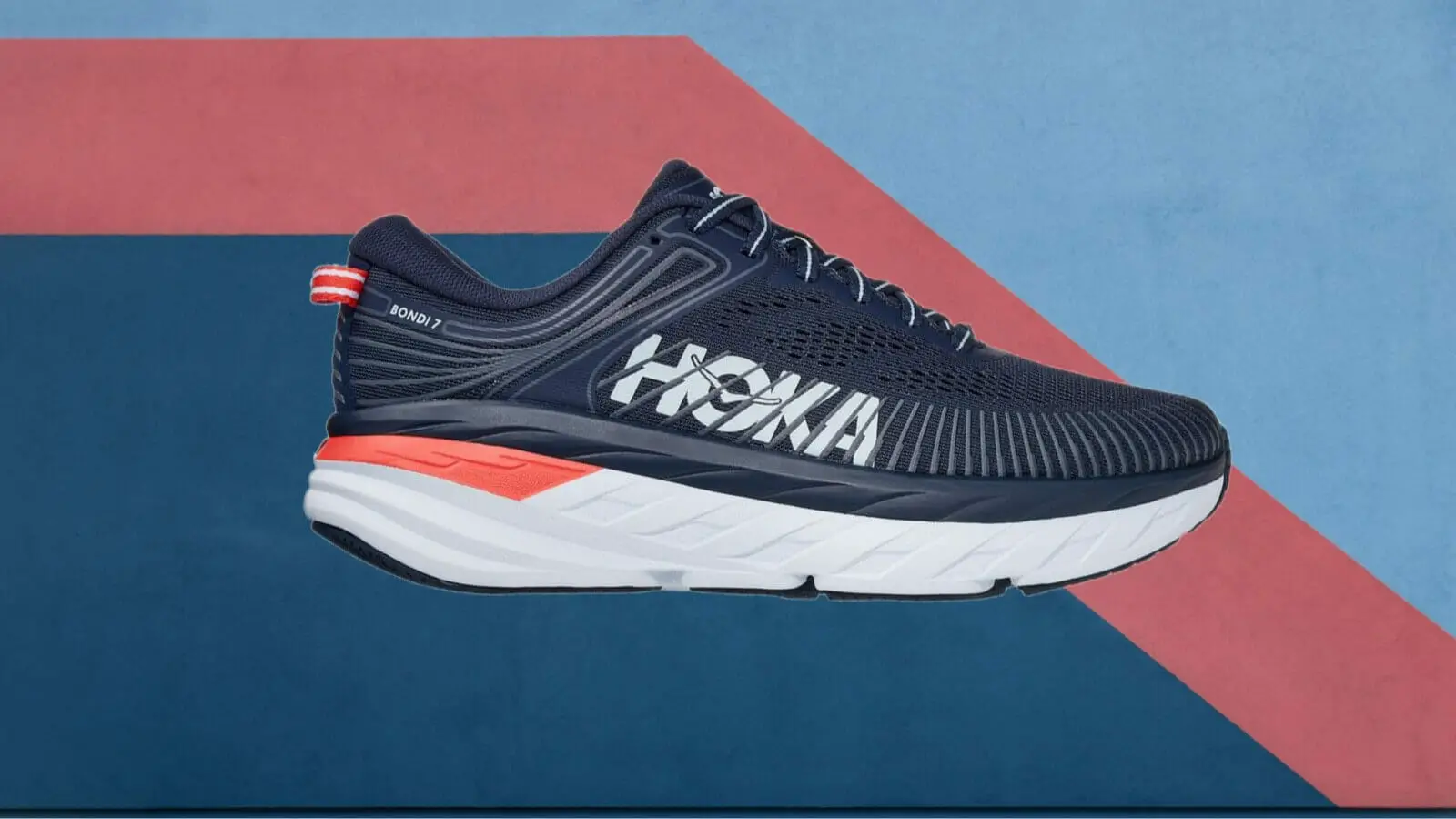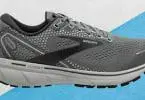The Hoka One One Bondi 7 is the quintessential Hoka running shoe. It features the maximalist midsole and endless cushioning that almost defines the brand. If you've never run in Hoka's before, read on and get our insights on the strengths of the brand. If you're a long time Hoka fan scoping out your newest shoe, we've got all the details for you as well as comparisons with Bondi 6, the Clifton, and a few other options from other manufacturers that have jumped into the maximum cushioning market.

Available for Men at
Available for Women at
The Bondi, along with the Clifton, is one of the most popular running shoes Hoka makes. This model has long served as the public face of Hoka's maximal cushioned, towering stack height philosophy. The Bondi endures for good reason.
The massive foam midsole of the Hoka One One Bondi 7 dominates the shoe. The upper almost escapes notice perched on top of the stacks of cushioning.
Fortunately, Hoka does not sacrifice running efficiency for the sake of cushioning. The rocker design of the midsole is obvious when looking at the shoes in profile, and it allows quick turnovers. The Bondi 7 strikes the right balance between smooth transitions and soft cushioning.
The other area in which the Bondi 7 excels is its stability.
First Impressions of the Hoka One One Bondi 7 Running Shoe
Unlike most running shoe makers, Hoka does not update their models every year. As such, we've feel like we've been waiting forever to get our hands on an updated Bondi model. Now that it's finally arrived, here are our first impressions of the Hoka One One Bondi 7 before we dive into the nitty gritty details.
As expected, the Bondi 7 has a lot going on. You will not mistake this for a minimalist running shoe. You won't even mistake it for something a comfortable, neutral shoe like the Brooks Ghost. This is a maximal running shoe with Hoka's signature gravity-defying stack height giving maximal cushioning a new meaning.
The Hoka One One Bondi 7 is not for everyone. Hoka markets the Bondi 7 as it's most cushioned shoe. It won't help you break any speed records, but if you love the maximalist approach of Hoka, and want something that will provide the most possible cushioning, then the Bondi could be the right choice for you.
One thing to note, Hoka has introduced a more performance-oriented version of the Bondi, dubbed the Bondi X. We'll get into a comparison of the Hoka One One Bondi 7 and Bondi X below, but the primary selling point of the Bondi X is a carbon plate to improve energy return and performance.
The Upper: Fit, Form, and Materials
Although most Hoka shoes have a normal fit, the Bondi 7 definitely runs on the narrower side. The upper feels narrower than the Bondi 6 to us, and most reviews back this up. Fortunately, Hoka do offer the shoe in a wide version, and we think that will suit a lot of runners who typically go with a medium width shoe. Of course, if your feet are on the narrower side then this might suit you better.
Breathable Mesh Upper
Hoka manufactures the upper from multiple layers of engineered mesh with above average breathability. The Bondi 7 has an array of overlays around the toe box and on other areas of the upper which adds structure to the forefoot and midfoot areas. This also serves to provide a bit of extra protection for the mesh materials and your feet.
One downside of the mesh upper here is the lack of flexibility. While the toe box height is fine and should accommodate most runners, the mesh itself has very little stretch to it. For a shoe that already runs on the narrow side, this could be a problem for those with wider feet.
Memory Foam Collar
One of the new features of the Bondi 7 that distinguishes it from the 6 is the memory foam collar. The collar features a dense memory foam that expands to fit the shape of your foot after you compress it while putting the shoe on.
This gives an extremely secure fit around the ankle and Achilles, and is one reason we recommend this shoe highly for people with plantar fasciitis. That secure fit keeps the shoe firmly in place which helps to alleviate strain on the plantar fascia. (Insecure fit around the heel can aggravate the condition, and is the same reason things like flip-flops are so problematic for people with plantar fasciitis.)
The Sole of the New Hoka One One Bondi 7
If you like Hoka One One shoes, the Bondi 7 midsole stack will not disappoint. Featuring the same compression-molded EVA foam as other Hoka running shoes, the Bondi 7 has a familiar feel under foot. Although higher performance foams (such as TPU or Pebax) show up in a number of shoes these days, many runners still find EVA the most comfortable, even if they give up a bit in absolute performance.
Medium Density
The medium density foam of the midsole on the Bondi 7 makes for a more versatile option. This can let you use it as more of a daily trainer, rather a traditional max-cushioned shoe. Our experience is that this shoe excels at easy-paced runs in the 10-15 mile range.
One cautionary note is that the midsole here is a bit firmer than many other Hoka options. This might make the Bondi 7 less suited to your recovery runs. Middle-distance daily training runs are really the sweet spot for this shoe.
Meta-Rocker
Another staple of the Hoka design philosophy is the rocker geometry of the sole. The shoe sole itself is stiff, but features a rocker design that allows you to roll through transitions instead of having the sole flex. This improves running efficiency. Given that Hoka is a pioneer of this type of running shoe design, it's no surprise they get it right here.
The Bondi 7 actually improves on the meta-rocker design of many of its siblings by having a stiffer forefoot as well. This allows the rocker geometry to really perform more effectively to get you through transitions.
Stability
This is a very forgiving running shoe. It features a wide base to allow for a planted feel on your feet no matter what your foot strike position you have. The additional firmness of the midsole also helps remove lean bias that you can sometimes find in shoes with such a high stack height.
These also have a raised edge around the perimeter of the shoe that helps center your feet. This is similar to the "guide rail" system found in virtually all the Brooks running shoe models these days (particularly the Brooks Adrenaline GTS and Brooks Glycerin models).
Overall, the Hoka One One Bondi 7 feels like a stability shoe, even if it is technically a neutral running shoe.
Outsole
This is one area we think the Bondi 7 falls short. While there is plenty of blown rubber on all of the high wear areas of the outsole, there is also plenty of exposed foam. Our experience is that this wears down quite quickly and limits the useful life of the shoe. A number of customer reviews also mention problems with quality and longevity of the outsole.
That said, the outsole does have great traction on road runs. If you plan to run in mostly good conditions on paved or otherwise well-maintained surfaces, then the outsole should prove sufficient. However, be aware of the tendency for these to wear down if you're putting in lots of miles in less-than-ideal running surfaces.
Use Case: The Hoka One One Bondi 7 for Plantar Fasciitis
People finding themselves struggling with pain associated with plantar fasciitis likely won’t be keen on the idea of going for a run. Plantar fasciitis is the most common cause of heel pain in adults and children worldwide, and this commonality goes double for runners.
Many who suffer from plantar fasciitis know that the hot spot for heel pain comes after long periods of prone activity, such as sleeping, flying, and extended sitting. However, sharper pains are common both during and after runs, especially when wearing incorrect or ill-fitting running shoes.
Plantar fasciitis treatment typically will involve routine stretching and plyometric exercises. But, one of the easiest methods to immediately notice easing of pain is to wear shoes that support the heel and arch properly.
The Hoka One One Bondi, while probably the least known of the shoes on our list, is an example of a shoe built specifically for the purpose of alleviating plantar fasciitis pain.
Pros and Cons of the Hoka One One Bondi 7
It’s impossible to find an absolutely perfect running shoe for plantar fasciitis. Regardless of the miles you plan to put on your running shoes, and regardless of the brand recognition that the shoe manufacturer may come with. This is the case with the Hoka One One Bondi as well. Here are some of the pros and cons that we came across when testing and researching these shoes.
Pros
- The fit is the most accurate to the sizes that are listed online of any of the shoes that we tested in our plantar fasciitis research.
- These running shoes, with their advanced and super thick cushioning, provided the strongest support of any of the shoes that we tested.
Cons
- Some have said that the Bondi goes a little too far in cushioning. In fact, this is their most heavily cushioned running shoe, from a brand that is already well known for going to the extreme when it comes to cushioning.
- These wear out far faster than any other running shoes for plantar fasciitis that we have tried. If you run a lot you will need to replace these every six to eight months.
Final Thoughts on the Hoka One One Bondi 7 Running Shoe
The Hoka One One Bondi 7 and it's oversized midsole divides opinion, much like the Hoka brand in general. If you don't mind losing a strong feel and connection with the ground under your feet, the huge stack height provides great cushioning, while the rocker bottom mitigates some of the performance issues associated with that stack.
We also think the memory foam collar is a big upgrade with the 7, and makes this shoe a great one to try if you're battling with Achilles pain, heel pain, or plantar fasciitis.
Available for Men at
Available for Women at







I am wondering if anyone else has experienced multiple falls while wearing the new Hoka one Bondi 7. I have fallen 3 times in 10 months with two elbow fractures. I hit areas of uneven ground in all three cases and and after thinking it through, the shoe seems to knock me off balance and propel me forward. The ground was uneven on the side of the shoe, which then rolled my ankle and caused a full face plant each time.